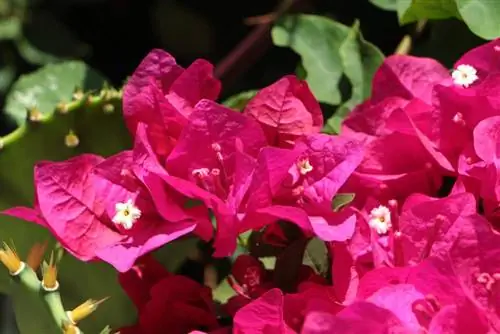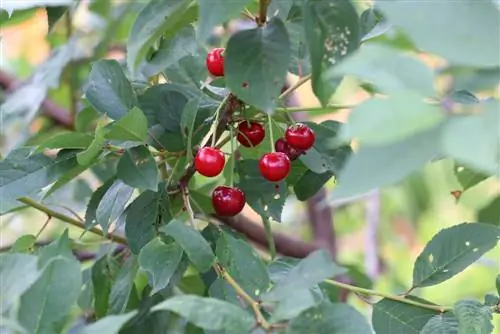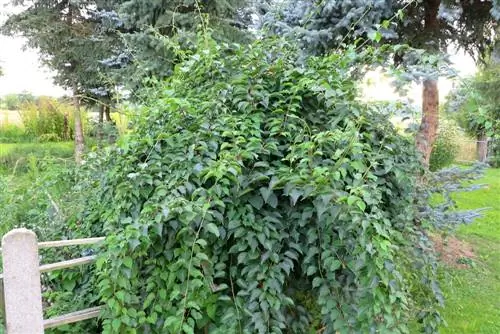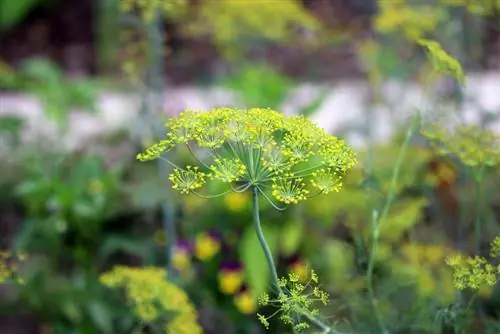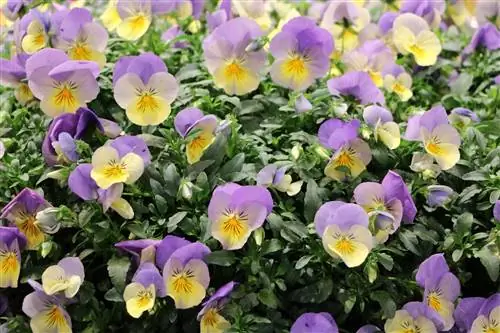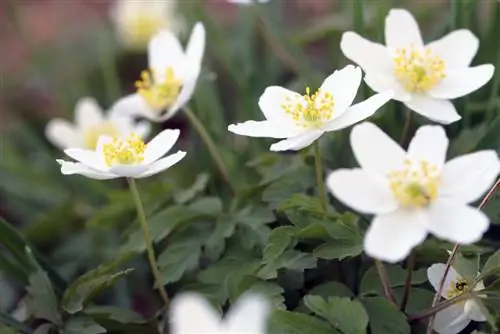- Author admin [email protected].
- Public 2023-12-17 03:39.
- Last modified 2025-06-01 06:48.
The bright light of the sun, azure sea and a few splashes of bougainvillea here and there. This is summer lightness - pure holiday feeling! The longing for it makes this flowering climbing plant a popular guest in the garden or balcony. Admittedly, this impressive facade decoration has to be a bit modest in this country, but with the right care the bougainvillea still becomes a real feast for the eyes.
Appearance
Bougainvillea is a tall climbing plant that produces many flowers. Depending on the variety, these shine in white, orange, pink or red. However, the purple version is best known. These “flowers” are actually three bracts that envelop the rather inconspicuous flower. The silky, shiny, green foliage is also decorative. The freshly sprouted leaves in particular are pretty to look at when they turn an elegant bronze tone due to the sun's influence.
Growth habit
The rapid growth and flexibility of the shoots enable a variety of appearances. Whether as a climbing plant, bush or standard tree, the miracle flower, as it is also called by flower lovers, can do almost anything with it.
Varieties
There are around 20 varieties of the miracle flower, which differ primarily in the color of the flowers. The Bougainvillea gabra is particularly recommended for cold winter quarters as it is the most robust variety. Although Bougainvillea spectabilis grows tall, it produces fewer flowers.
Location
The bougainvillea also wants to feel at home in the far north and therefore expects a warm and sunny place where it will thrive and produce lots of flowers. Therefore, please consider the following points when choosing a location:
- heated winter garden is suitable all year round
- Staying outdoors is possible from May to September
- warm and sunny place is optimal
- flower formation suffers in partial shade
- A location on the south wall or wall provides additional warmth at night
- Covered space protects against damage caused by heavy downpours
- From October she has to go into winter quarters
Tip:
If you really want to enjoy the bougainvillea directly in the garden, you can plant it out in spring and put it back in the pot in autumn. This is a bit laborious but definitely possible.
Planting soil
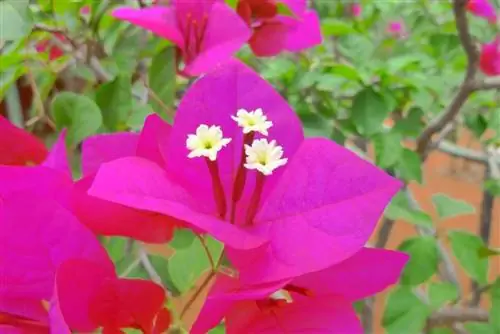
Garden centers offer special potting soil for potted plants that is airy and water-permeable. Since it is a little more expensive than normal potting soil, it may be worth mixing it up yourself. The savings are particularly noticeable if you have a lot of large potted plants and therefore need a lot of soil. The basis is the simple potting soil with around 70%, but without peat. For the remaining 30%, use equal parts lava rocks and quartz sand. This mixture is expanded with some horn shavings to provide a long-term supply of nutrients.
Pouring
Bougainvillea plants always need moist soil so that they produce their “flowers” in abundance. Regular watering is a must during the growing season and requires great care. The bougainvillea does not tolerate too much moisture or dryness. The first quickly leads to root rot and the death of the entire plant. However, if it doesn't get enough water and the substrate dries out completely, it will quickly lose its leaves, even in summer. After it is watered again, it usually recovers and sprouts again after a few weeks.
If the summer is hot, the pot saucer must be filled with water in the morning and evening because at high temperatures the water evaporates quickly and the substrate dries out. Plants that have had to go without water for a long time look lifeless, but that can be deceptive. Even if all parts of the plant above ground have died, residual moisture in the pot may have provided the roots with a makeshift supply. It's worth watering the plant, sometimes it unexpectedly comes back to life.
Fertilize
During its growing season, the triplet flower needs a mineral fertilizer for flowering plants every 14 days. From June to August you should even fertilize weekly. In addition to various trace elements, the suitable fertilizer primarily needs the following nutrients:
- Nitrogen for growth
- Potassium for he alth
- Higher amounts of phosphate for flower development
When repotting, there is also the opportunity to add organic fertilizer. Horn shavings or horse manure decompose slowly and release nutrients to the triplet flower over a long period of time. However, it is difficult to determine the exact nutrient composition and quantity.
Note:
The desire for abundant flowers can quickly tempt you to fertilize more than necessary. This is harmful to the roots and leaves, which then develop brown edges and spots.
Repotting
The bougainvillea needs a new pot every 2-3 years, which should only be slightly larger than the old one and also have a drainage hole. A small container supports the formation of flowers. A container that is much too large will result in plenty of leaf mass and strong root development but rather sparse flowering. Spring, after leaving winter quarters, is the ideal time for repotting. Use a loose and permeable plant substrate with some humus content.
- Take the plant out of the old pot and examine the root thoroughly.
- Remove dead roots and uninvited guest plants such as clover.
- Place a shard of pottery over the drain hole of the new pot, which will prevent it from clogging later.
- Enrich the first layer of soil with some poroton or lava rock so that excess irrigation water can drain away better.
- Place the ball of the bougainvillea on this first layer of soil, always a few centimeters lower than the edge of the pot.
- Keep the trunk straight and fill the spaces with soil.
- Press the soil lightly.
- Put the repotted triplet flower back in its place
- Now pour heavily.
If the coaster fills with water when pouring, this means that the drainage layer is well done and waterlogging is definitely avoided.
Tip:
Get help repotting, especially if your bougainvillea is large. It is easier if a helper holds the plant in a suitable position while you fill in the soil.
Climbing aid

The bougainvillea is a strong-growing climbing plant that clings to walls in its native home. This is not possible in our latitudes as it can only be cultivated permanently in pots. But even in the pot it needs suitable support so that the long shoots do not grow tangled. With a suitable climbing frame, the triplet plant can easily reach heights of up to three meters in this country.
- Use a trellis or prefabricated trellises from the garden center
- simple sticks are also suitable
- transportable climbing aids make moving to winter quarters easier
- Attach the climbing aids in or to the bucket
- Trellis attached to the wall is less suitable
- Adjust the climbing aid accordingly when repotting
- Use your hand every now and then to maintain a nice shape
Tip:
Three bamboo poles, which are inserted into the ground a little apart from each other and tied together at the top, are ideal for giving the bougainvillea the structure of a pyramid.
pruning
The bougainvillea grows very quickly and requires pruning several times a year. This is no problem as it is extremely easy to cut. The result is:
- a beautiful shape
- tamed growth
- more bloom
- a he althy plant
There are two possible times for the major pruning: when the plant moves into or leaves its winter quarters. It is also possible to divorce both times. Initially in the fall just enough to fit the bougainvillea into its winter quarters, followed by the large fine cut in the spring. The plant is then still free of leaves, which makes pruning easier. The sequence for the big cut is as follows:
- Use clean and sharp secateurs.
- First cut off all shoots that died over the winter.
- Then cut off all side shoots, always directly on the main shoot.
- Shrink the main shoots if necessary.
- Remove all shoots under the crown of the standard tree.
- Always keep the desired shape in mind.
Tip:
Appearances can sometimes be deceiving: Use a sharp knife to test whether a shoot still has vitality by scraping off a small piece of the bark.
If the plant grows a lot during the summer or the flower production is declining, you can always use scissors. Shorten the newly grown long shoots. Afterwards, many short shoots will develop that will bloom vigorously. Withered bracts, the so-called flowers, do not need to be cut, they fall off on their own.
Propagation
New plants are available in garden centers all year round, with the beginning of summer being the best time to purchase. Since the plants are not among the cheapest potted plants, propagating them yourself from cuttings is worth considering. You can never have enough bougainvilleas, but small plants are also a welcome gift for plant lovers. Propagation is challenging and not always successful for laypeople, but it is still worth a try. Early summer is good for this.
- Use clean and sharp scissors
- Cut 30 cm long cuttings.
- Plant the cuttings immediately
- Keep the soil temperature at around 25 degrees and the soil moist.
After a few months, which requires a lot of patience, it will become clear whether the cutting has rooted.
Tip:
Use a rooting hormone to increase the chances that the cutting will develop into a real plant.
Diseases and pests
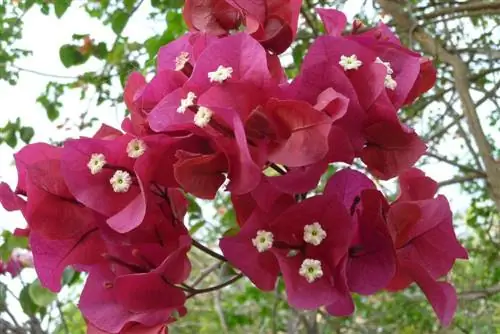
The bougainvilleas are relatively robust. However, care errors can lead to various damages. Lack of water and dry weather favor spider mites. In the winter quarters, however, scale insects like to spread. The bougainvillea, like other potted plants, should therefore be regularly checked for pest infestation in its winter quarters.
If pests are discovered, quick action is necessary so that the plant survives and no other plants are infected. Treat the plant with a suitable product and cut off parts of the plant if necessary. To avoid further infection, the infected plant can be isolated from he althy plants, provided there is space for this.
Warm winter quarters
The bougainvillea definitely needs a winter quarters as it is not hardy and can only withstand very light frosts for a short period of time. Fortunately, it gives its owner a certain amount of leeway when it comes to providing winter quarters. It can overwinter in both a warm and a cold place. Depending on the weather, the wintering phase can begin as early as October. A warm quarter should meet the following requirements:
- it has to be light
- Sunny if possible
- be heated as little as possible
- with average temperatures in the range of 10-15 degrees
- A “barely” heated winter garden is ideal
Water the plant regularly and as needed. It could well be that, under these conditions, the bougainvillea will give you one or two flowers even in winter.
Cold winter quarters
Whenever possible, warm winter quarters should be preferred. If there is no warm winter quarters for reasons of space, a cold winter quarter can be used. Garages, basements or sheds are suitable for this, provided they meet the following conditions:
- they must be dark.
- it can't be colder than 0 degrees
- the floors must not be freezing cold
If you have a greenhouse that is equipped with a frost monitor, you can overwinter the bougainvillea in it. The triplet flower loses all of its leaves in the cold winter quarters. That's not a bad sign. New leaves will emerge in spring. If the plant overwinters in cold weather, it needs very little water so that it doesn't dry out completely. About once a month should be enough, depending on the size of the container and the room temperature. Too much moisture causes rot and mold. If there is uncertainty here, a moisture meter makes sense.
Tip:
Place a Styrofoam plate or piece of wood under the bougainvillea pot to insulate from the cold of the soil. If there is no space available inside at all, a winter tent could be the solution.

